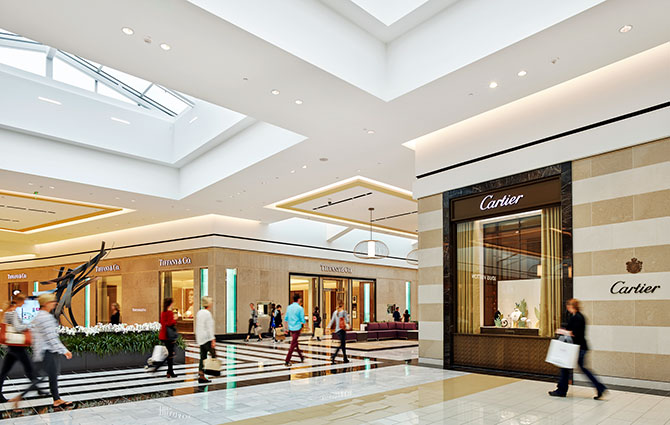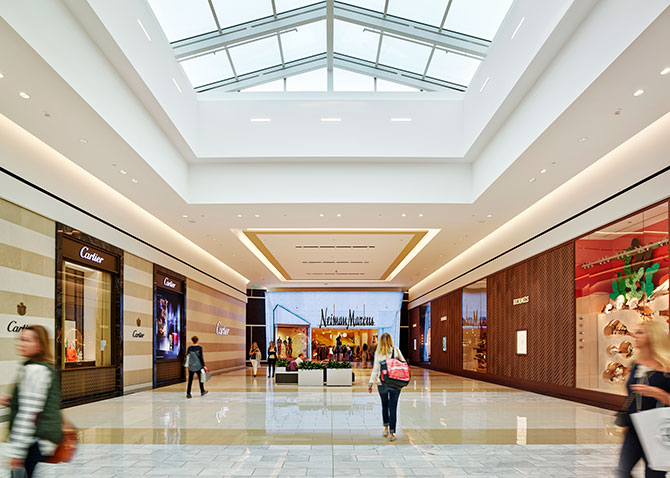
JCK’s ongoing series on the shopping centers finding success amid an ever-changing retail landscape
King of Prussia
160 N. Gulph Road
King of Prussia, Pa.
Poor George Washington. It’s sad enough that he had to watch 2,000 of his troops freeze and starve to death during the winter of 1777 in what is now Valley Forge National Park, just outside Philadelphia. But the guy still gets no respect. Sure, 1.2 million tourists may visit the park every year. But it plays underdog to an attraction 3 miles down the road: a shopping mall. The King of Prussia mall hauls in some 25 million visitors annually. It was named, like its hometown of King of Prussia, Pa., for an 18th-century local tavern, which was in turn named for King Frederick the Great of Prussia. And since its inception, as a dreary, open-air snooze of a shopping plaza in 1963, it has cheated death and beaten the odds. Indeed, as malls across the nation wither and starve—financial analysts Credit Suisse estimate that at least 25 percent of the remaining 1,100 sites could close within the next five years—King of Prussia grows by the month. It’s now one of the big-deal destinations in the Philadelphia metropolitan region, considered as necessary as Independence Hall, the Liberty Bell, the cheesesteak, the steps of the Philadelphia Museum of Art (climbed by Sylvester Stallone in Rocky), and noble Valley Forge.
 Now, we Philly folks are suckers for history. Especially when we’re the ones making it—in underdog tales of survival and redemption, à la Rocky Balboa and the Philadelphia Eagles (your 2018 Super Bowl champions). The King of Prussia mall slides neatly into this narrative. On the face of it, there’d seem to be no sane explanation for the triumph of the 450-store behemoth. If we’re talking jewelry—and, of course, we are—it’s a mishmash of luxury (Cartier, Tiffany & Co., and Philadelphia icon Bailey Banks & Biddle) as well as the longtime companions of mall leasing agents everywhere (Kay Jewelers, Zales, Piercing Pagoda). If we’re talking fashion, Jimmy Choo, Stuart Weitzman, Diane von Furstenberg, and Carolina Herrera offer their only Pennsylvania boutiques here. They snuggle up against Aéropostale, the Gap, and American Eagle. And there’s food. Lots of food. Some 40 restaurants and the best cheesesteaks north of South Philly’s Passyunk Avenue.
Now, we Philly folks are suckers for history. Especially when we’re the ones making it—in underdog tales of survival and redemption, à la Rocky Balboa and the Philadelphia Eagles (your 2018 Super Bowl champions). The King of Prussia mall slides neatly into this narrative. On the face of it, there’d seem to be no sane explanation for the triumph of the 450-store behemoth. If we’re talking jewelry—and, of course, we are—it’s a mishmash of luxury (Cartier, Tiffany & Co., and Philadelphia icon Bailey Banks & Biddle) as well as the longtime companions of mall leasing agents everywhere (Kay Jewelers, Zales, Piercing Pagoda). If we’re talking fashion, Jimmy Choo, Stuart Weitzman, Diane von Furstenberg, and Carolina Herrera offer their only Pennsylvania boutiques here. They snuggle up against Aéropostale, the Gap, and American Eagle. And there’s food. Lots of food. Some 40 restaurants and the best cheesesteaks north of South Philly’s Passyunk Avenue.
The mall would seem to lack any specific personality or identity. Visitors come purely for the retail. You won’t spot celebrities here—the only boldface shoppers mall historian and author Michael Stefan Shaw can dredge up are Richard Nixon (during a 1968 campaign stop), actor Charlton Heston, and celebrity chef Michael Symon. You don’t feel more important than your neighbors for having stepped inside, as you might, say, at the swank-tacular Bal Harbour Shops in Miami. And you won’t come for the last hope of many American malls: sideshows, death-defying cirques, or fountains dancing to show tunes. There’s no indoor amusement park here, no Hall of Legos, no marzipan topiary. And yet, according to retail analyst Green Street Advisors, King of Prussia earns an average of $975 per retail square foot. The most recent national mall average: $472 per square foot.
Another mystery: It may or not be the “largest mall in America,” so you can’t even brag that you’ve been there, walked that, with any certainty. The International Council of Shopping Centers ranks it first in terms of leasable space, with 2.9 million square feet. But if sheer square footage is your thing, you may be happier in the Mall of America, outside Minneapolis, with its 4.2 million square feet and 90 additional stores. For every analyst you ask, a different ranking emerges for both malls. But how King of Prussia—or KOP, as anyone who’s anyone here calls it—got so big is also a head-scratcher. It sits 19.9 miles from central Philadelphia, and the drive in traffic can be excruciating. The mall has flourished without a single direct link to mass transportation, and the influx of vehicles can be, as my mother likes to put it, a giant case of “Oh, my goodness.”
 But it’s traffic—retail traffic—that makes all the difference. As Suzette Parmley reported in The Philadelphia Inquirer, KOP is within a “day’s drive of 40 percent of the U.S. population…with more than 59,000 people working nearby…and an average household income of $120,000 within 3 miles.”
But it’s traffic—retail traffic—that makes all the difference. As Suzette Parmley reported in The Philadelphia Inquirer, KOP is within a “day’s drive of 40 percent of the U.S. population…with more than 59,000 people working nearby…and an average household income of $120,000 within 3 miles.”
This is, after all, the Main Line—the blue-blood enclave of The Philadelphia Story, where spoiled heiress Tracy Lord, played by Katharine Hepburn, spouts, “George comes from the so-called lower class…the upper.” And therein may lie the secret to this mystery. KOP seduces every demographic. The eight anchor stores range from another Lord (Lord & Taylor) and Neiman Marcus to Macy’s and Dick’s Sporting Goods. “I don’t feel overwhelmed or like I have all this attitude when I go there,” says veteran shopper Judy Oddo of suburban Bucks County. “I brought my kids here with me in the 1970s, and now I can bring my grandkids here.” She adds: “I just have to keep hydrated. It’s big.”
Philly fireplace mantels are littered with pics of kids posing with the giant bear at KOP’s FAO Schwarz. And sports fanatics (i.e., every Philadelphian) still come to see the former home of their pro tennis team, the Philadelphia Freedoms. The mall parking lots are so vast that the team plunked its courts right there amid the cars.
But in Philadelphia, football is king. So, when the Philadelphia Eagles crushed the Minnesota Vikings, 38-7, to reach the Super Bowl, a retail rivalry ensued. The game was played in Minneapolis, only 15 minutes from the Mall of America. In the days before kickoff, Eagles fans invaded the mall, chanting “E-A-G-L-E-S” and wearing underdog canine masks. Police banned the masks and the noise. Eagles fan Marc Maloso of northeast Philly said, “I’ve always wanted to cross this [off] my bucket list.” What, the Super Bowl? “No, the Mall of America.” When asked if he had ever been to KOP, he said, “No, that’s not as big.”
Says who?
Fun fact: King of Prussia is owned by Simon Property Group. Among SPG’s other malls: Roosevelt Field in Garden City, N.Y., and the Galleria in Houston.